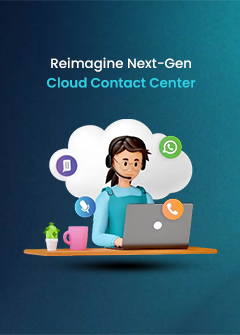In a typical call center telephony software, phones ring non-stop and agents are constantly taking calls.
However, when agents are overwhelmed and unable to handle the volume, problems arise.
Customers get frustrated waiting on hold, agents apologise repeatedly, and both parties end the call feeling unsatisfied.
The root of the issue lies in the call center management system.
Inadequate call routing, missed calls, long waiting times, and incomplete customer information are some reasons why customers become infuriated.
The call management system or call center tracking systems is disorganised and inefficient.
The main challenge for call centers is to keep operations streamlined and ensure that both agents and customers have a positive experience.
What is Call Center Software?
The primary goal of call center software is to improve and optimise the operational procedures and communication in a customer service or call center setting.
The fundamental component of call center software is call center phone software, which acts as the foundation for voice-based communications between customer support representatives and customers. In order to provide effective call management and excellent interaction with customers, this call center telephony software frequently includes features like interactive voice response (IVR), call recording system, and automatic call distribution (ACD).
Modern call center software extends beyond traditional calls, integrating channels such as:
1. Email
2. Chat
3. Social media
Other perks include:
Call center telephony software is a vital feature, allowing supervisors to track and monitor agent performance via call center tracking systems.
Small businesses benefit from virtual call center software tailored to their specific needs.
Choosing the best call center software involves careful evaluation of features, scalability, and compatibility with the business’s specific requirements, whether in India or any other region.
Before setting up a call center, it’s crucial to choose a remote call center software that has these essential features:
- Call routing
- Interactive Voice Response
- Missed call handling
- Comprehensive customer information
- Integration with other channels
- Omnichannel Support
- Real-Time Analytics and Reporting
- Call Monitoring and Whisper Coaching
- Multi-language Support
- Screen Pop-ups and Customer Info when the call arrives
- Workforce Management
- Call Scripting
- Call Queuing with Estimated Wait Time
- Option for a callback
- Integration with Helpdesk and Ticketing Systems
- Multi-language Support
By selecting a call center phone software with these features, you can improve efficiency, provide better customer service, and avoid frustration for both agents and customers.
So, before setting up a call center, you must ensure that the call management system you’re going to install, comprises these essential call center software features listed below.
Key Features Every Call Center Phone Software Needs
Some of the key features a call center software must have:
1. Interactive Voice Response (IVR)
An Interactive Voice Response is the first voice customers hear right after contacting you. IVR service helps you pick your customer calls instantly and be available 24*7.
It interacts with your customers via DTMF keypad tones and gives your callers customised responses. In other words, an IVR number acts as a virtual receptionist.
It helps you greet your caller with a personalised welcome message, and communicate to your callers in their local language.
You can also convey messages through IVR if there is a long call queue, or there is an issue that needs to be resolved because of which the customer might have to wait.
During holidays as well if a customer calls just convey through the IVR greeting that you will get back to them after the holiday season.
It helps in giving a rich calling experience to your customers. Eventually, because of advanced features of call center calling services, your customers will start giving you brownie points for impeccable service.
Also, your customers can help themselves too if an issue does not need the assistance of an agent.
As per the statistics, 43% of customers prefer Virtual call center software that provide bots to simplify customer service. So there is no way that you can leave the IVR solution out of the picture when it comes to your call center.

2. Automatic Call Distribution (ACD)
Automatic call distribution ensures calls are automatically routed to the right agent thereby reducing the waiting time of customers.
It is a prerequisite of every call center routing software as it helps in the systematic handling of customer calls.
When you set up a cloud call center solution, you can easily customise the sequence or criteria of routing customer calls.
Later on, you can modify it as well depending upon the call volume or customer requirements.
A few ways in which calls can be routed in a call center routing software are performance-based routing, location-based routing, routing calls to the idle system, least occupied routing, etc.
3. Intelligent Call Routing – Call Center Routing Software
Efficient call routing is essential to ensure that customers are connected to the right agent who can address their needs effectively.
Look for a call center routing software that offers intelligent call routing capabilities.
This feature of call center uses advanced algorithms to analyse caller information and direct calls to the most appropriate agent based on skill set, availability, or other criteria.
It reduces call transfer rates, minimises wait times, and improves customer satisfaction.
Up to 30% less time is typically spent on each call owing to intelligent call routing regarding it as one of the best call center phone systems features.
When they couldn’t get through to a customer support agent, 67% of customers hung up the phone in annoyance.
4. Call Center Tracking Systems and Monitoring
Call Centre Tracking Systems keeps a track of all your business calls 24*7. Managing a call center while keeping both the agents and the customers happy is a tough task.
Though, technology has now made it easy.
With the help of the call tracking feature, you can track if all the calls are being answered, and monitor the performance of each individual agent on call center telephony software.
Now, agents are not under constant orders. They just know that they are being watched, and they’ll perform their best making it one of the essential call center software requirements.

5. Live Call Transfer
This feature fits perfectly in the call center requirements checklist as it enables agents to transfer calls to another agent simply from their mobile phones, without disconnecting the call.
Let’s say, if an agent is unable to solve an issue, he can transfer the call to his senior or someone from another department without disconnecting the customer’s call.
This will help reduce the waiting time of the customer as well as enhance the customer experience. Are you still thinking why or how to choose a best call center software, we got more features of call center coming up.
6. Call Center CRM features- CRM Integration
Call center Phone software that integrates with other CRM software like Pipedrive and salesforce, provides agents with a 360-degree view of the callers, which helps agents provide a personalised experience to the callers.
Whenever anybody calls you on your toll free number, the agent can see all the information related to that customer or prospect.
In call center CRM feature addition to seeing call logs, the agent will have access to previous tickets, cases, events, notes, chat transcripts, and more.
This information will help busy call center agents become more organised, efficient, and effective.
7. Outbound Call Solution
The world is getting faster day by day. You can transfer money with one click, buy anything you want without having to go out, and whatnot.
If we have our phones in our hands then we have the entire world at our fingertips. Then why do you want your agents to dial every number manually whenever they have to make an outbound call?
Improve your call center’s functioning and productivity of your employees by getting outbound calling solutions for your business.
It will not only handle your agent’s tedious tasks but also increase their productivity by increasing their on-call time. Furthermore, it will facilitate you in running a top-quality outbound call campaign.
The best part is yet to come. To incorporate all these features of call center you do not need a physical infrastructure or a physical call center for that matter.
You can build a Virtual call center software on the cloud and utilise the benefits of cloud telephony while working from a remote setting. Now save infrastructure costs while also levelling up your customer service.

8. Support Throughout all Channels
Customers expect to be able to contact businesses through many channels, including phone calls, emails, chat, social media, and the WhatsApp API in the age of digital communication.
Your call center operators may handle client inquiries and concerns across many platforms with the help of call center management system with omnichannel support.
Customers no longer have to repeat information when changing channels thanks to this functionality, which guarantees consistent customer experiences. A customer contact center software is also quite beneficial in such instances..
As per a survey, 70% of customers expect companies to offer a uniform experience across all communication platforms.
The average customer retention rate for businesses with effective omnichannel customer engagement strategies is 89%, compared to 33% for businesses with subpar methods.
9. Real-Time Analytics and Reporting
Call center software small businesses or any other medium or large enterprise managers expect access to real-time analytics and reporting in order to make data-driven choices and continuously enhance performance.
Such a feature offers information on call volumes, agent efficiency, client wait times, and other crucial parameters.
Supervisors are better able to identify areas for improvement and allocate resources efficiently with timely access to this information.
Customer satisfaction rises by 31% for businesses using real-time analytics in their call center phone software.
Real-time analytics and reporting are essential to the operations of 63% of call centers.
10. Whisper Coaching and Call Tracking
For the purpose of quality control, supervisors must have the capacity to listen in on agent calls.
Call Center Phone Software should have call tracking system functions that let managers listen in on calls in private.
Furthermore, managers can give in-the-moment advice to agents through whisper coaching without the customer hearing.
This enhances the effectiveness of agents and guarantees consistently high-quality service.
Agent performance can be elevated by up to 15% thanks to call monitoring.
Customers’ interactions with call center management system representatives account for 92% of how they decide how they feel about a business.

11. Screen Pop-ups and Customer Info when the Call arrives
Having quick access to client data is essential for providing individualised experiences.
The call center routing software should flash up with relevant customer information when a call is received.
As a result, agents may immediately access customer account information and address clients by name, providing effective and individualised service.
When businesses contact, 87% of customers want access to their account information.
Customer spending might increase by up to 500% as a result of personalised customer experiences with the help of contact center software features.
12. Managing the Workforce
Workforce management features in call center software are essential for optimising agent scheduling and ensuring sufficient staffing levels.
To make effective schedules, this call center phone systems feature takes into account things like call volumes, agent availability, and skill sets.
Companies can minimise wait times and increase agent productivity by matching staffing levels to demand.
Software for managing the workforce can cut the cost of staffing call centers by up to 20%.
According to 74% of cloud contact center, effective labour management increases customer satisfaction.
Unlock the Power of Cloud Contact Center Solutions
Embrace the future of customer service

13. Call Scripting
With the use of call scripting, your agents can give customers consistent and precise customer service in the call center software.
With call scripting, agents have access to prewritten scripts and prompts, ensuring they never forget crucial information or struggle to find the appropriate words.
The first-call resolution rates are increased and professionalism is maintained owing to this functionality.
Studies show that call scripting reduces call handling time by 25% and increases agent productivity by 15% in businesses that utilise it.
14. Call Queuing with Estimated Wait Time.
When customers contact your call center phone software, it’s essential to provide them with a smooth experience.
Call queuing with an estimated wait time feature allows you to manage incoming calls efficiently.
By informing customers about their estimated wait time, you set realistic expectations and reduce frustration.
This transparency fosters customer satisfaction and improves their overall experience thus making it a basic part of call center requirements checklist.
According to a survey by Accenture, 82% of customers agree that waiting too long for a response is the most frustrating part of a customer service experience.
Research conducted by Velaro reveals that 60% of customers are willing to wait on hold for only one minute before abandoning the call.

15. Option for a Callback
Waiting on hold can be tiresome for customers. Offering them an option for a callback empowers them to choose a more convenient time to receive assistance.
This call center telephony software feature not only reduces wait times but also allows customers to continue with their daily activities without being tied to the phone.
Implementing a callback option demonstrates your commitment to customer convenience and improves their experience.
A survey conducted by YouGov found that 72% of customers prefer a callback option instead of waiting on hold.
Research by Fonolo indicates that 32% of customers would be less likely to switch brands if a callback option was available.
16. Real-Time Collaboration | Feature of Call Center
Customer inquiries often require input from multiple team members, such as sales representatives, support agents, or technical experts.
Real-time collaboration within the call center management system enables your team to work together seamlessly.
By sharing information, discussing customer issues, and finding solutions collaboratively, you can deliver a more personalised and efficient service.
Real-time collaboration empowers your team to provide faster resolutions, resulting in improved customer satisfaction.
A study by the Aberdeen Group found that companies with collaborative customer support teams achieve an average customer satisfaction rate of 89%.
According to Salesforce, 80% of customers believe that the experience a company provides is as important as its products or services.

17. Integration with Helpdesk and Ticketing Systems
Integrating your call center management system with your helpdesk and ticketing systems enhances the efficiency and effectiveness of your customer support.
When agents have access to complete customer histories and past interactions, they can provide a more personalised and contextually relevant service.
Seamless integration streamlines the workflow, reduces duplicate efforts, and ensures consistent information across various channels.
By leveraging integrated systems, you can resolve customer issues promptly and create a seamless experience.
A study by HDI found that companies with integrated helpdesk and ticketing systems that can be said as the best call center software in India experience a 68% higher first-contact resolution rate.
Research conducted by ICMI indicates that 86% of customers are willing to pay more for better customer experience.
18. Multi-language Support
In today’s globalised marketplace, catering to customers who speak different languages is crucial.
Multi-language support in your call centre tracking systems allows you to serve customers from diverse backgrounds more effectively.
Whether it’s through language preferences, multilingual agents, or automated language translation, providing support to customer’s preference in your call center phone software.
According to a survey by Common Sense Advisory, 72% of customers are more likely to buy products or services in their own language.
Research conducted by Zendesk reveals that 67% of customers prefer self-service options when they are available in their language.
Are you ready to join Heyo Phone in embracing the linguistic diversity of India and connecting with customers in their mother tongues. The vernacular approach ensures that the ads and app content are available in Hindi, Bengali, Tamil, and more to come!


